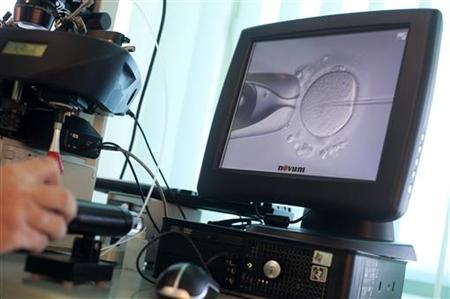
医生正在将精子注射进一个卵细胞
一项研究发现,在体外受精(IVF)中只将一个胚胎植入妇女的子宫内并不会降低成功受孕生产的几率,但这并不意味着更少的双胞胎孕妇就会减少所有相关的健康风险。
传统上,体外受精时植入多个胚胎,但这样会使接受体外受精的妇女怀上双胞胎或者多胞胎的几率上升好多倍,并以此增加怀孕期间母亲和婴儿的风险,包括糖尿病、早产和脑瘫。
但是,一项由爱荷华大学Jessica Kresowik主持的研究发现,技术的提高增加了受孕的可能,较年轻的妇女即使只植入单个胚胎也有很好的受孕概率。
“在过去,你必须植入多个胚胎以保证受孕,”Kresovik向路透社健康专栏的记者说明她的研究,这项研究发表在《生育和不育》(Fertility and Sterility)。
她补充说,在技术得到提高之前,医生们可能会一次使用6个胚胎,希望能够受孕成功。而美国生殖医学学会(American Society for Reproductive Medicine)建议,对于35岁以下的妇女,不应该使用超过2个胚胎。
Kresowik还说,每年,出生的婴儿中,通过体外受精受孕的只占1%,但是却占了双胞胎总数的17%。
自2004年以来,在Kresowik的生育诊所,所有38岁以下的妇女在进行第一次体外受精时,都只植入单个胚胎,结果良好。
实施这项政策前与实施之后5年数据发现,出生率并没有降低,相反,事实上还有所提高。
在实行单胚胎植入政策前,占全部接受体外受精妇女51%的38岁以下妇女有38%成功受孕并产下活婴,而实行该政策之后,这个比例提高到了56%。
而多胞胎的比例从35%下降至不到18%。
自2004年以来,有364名妇女符合标准植入单个胚胎,其中65%成功受孕产下一个活婴,双胞胎和多胞胎的比例仅仅为3%略多一点。新罕布什尔州达特茅斯-希契科克医疗中心(Dartmouth-Hitchcock Medical Center)的生育专家Judy Stern说,“像这样的政策真是个非常好的想法”。她并没有参与这项研究。
她对路透社健康专栏的记者说:“你真的可以向单胎植入方向前进,而且它的成功率很高,并降低了多胎发生率。”
相关英文论文摘要:
Five-years of a mandatory single-embryo transfer (mSET) policy dramatically reduces twinning rate without lowering pregnancy rates
Objective To report the outcomes of a program policy instituted in 2004 mandating single-embryo transfer (mSET) for all women aged <38 years, with at least seven zygotes, no prior failed fresh cycle at our center, and at least one good-quality blastocyst.
Design Retrospective cohort study.
Setting Academic medical center.
Patient(s) All women <38 years old undergoing a fresh cycle with autologous oocytes and all women undergoing a fresh cycle with donor oocytes from June 1, 1999, to May 31, 2004 (before mSET) and from June 1, 2004, to May 31, 2009 (after mSET).
Intervention(s) mSET policy implementation.
Main Outcome Measure(s) Live-birth rate, multiple pregnancy rate, clinical volume, and outcomes of all mSET fresh IVF transfers were analyzed.
Result(s) Clinical volume was unchanged between the two time groups. After implementation of mSET, live-birth rates improved from 51.1% to 55.9% and multiple-birth rates dropped from 34.8% to 17.5%. A total of 364 mSET fresh transfers were performed with a live-birth rate of 64.6% and a multiple-birth rate of 3.4%.
Conclusion(s) A mandatory SET policy based on prognostic factors can be instituted with no drop in clinical volume and no negative effect on delivery rates. Multiple gestation rates can be dramatically lowered.
英文论文链接:https://www.sciencedirect.com/science/article/pii/S0015028211025064







